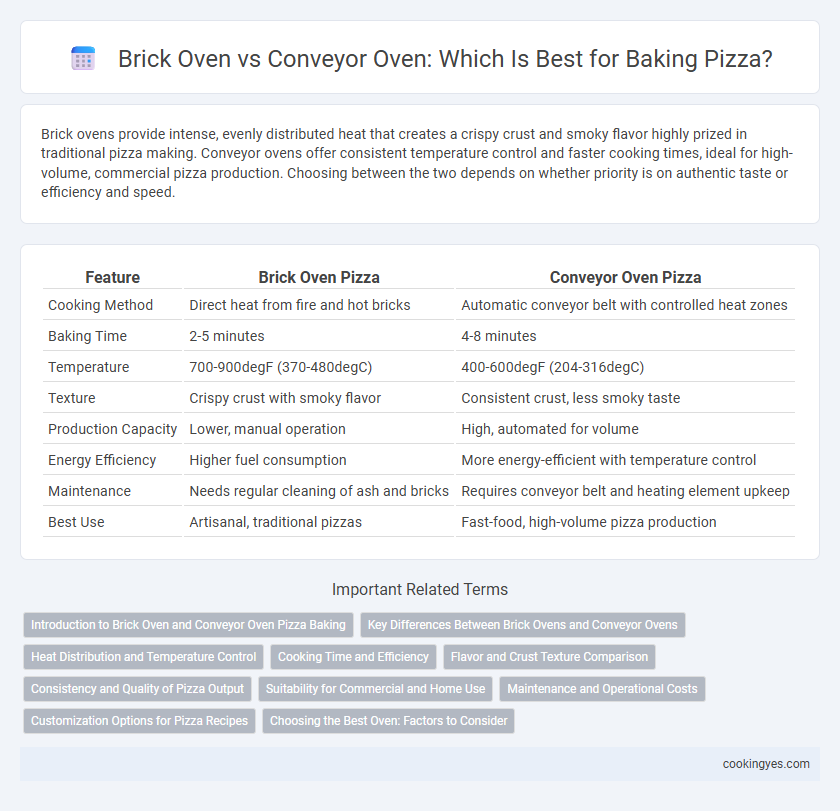Brick ovens provide intense, evenly distributed heat that creates a crispy crust and smoky flavor highly prized in traditional pizza making. Conveyor ovens offer consistent temperature control and faster cooking times, ideal for high-volume, commercial pizza production. Choosing between the two depends on whether priority is on authentic taste or efficiency and speed.
Table of Comparison
| Feature | Brick Oven Pizza | Conveyor Oven Pizza |
|---|---|---|
| Cooking Method | Direct heat from fire and hot bricks | Automatic conveyor belt with controlled heat zones |
| Baking Time | 2-5 minutes | 4-8 minutes |
| Temperature | 700-900degF (370-480degC) | 400-600degF (204-316degC) |
| Texture | Crispy crust with smoky flavor | Consistent crust, less smoky taste |
| Production Capacity | Lower, manual operation | High, automated for volume |
| Energy Efficiency | Higher fuel consumption | More energy-efficient with temperature control |
| Maintenance | Needs regular cleaning of ash and bricks | Requires conveyor belt and heating element upkeep |
| Best Use | Artisanal, traditional pizzas | Fast-food, high-volume pizza production |
Introduction to Brick Oven and Conveyor Oven Pizza Baking
Brick oven pizza baking offers high heat retention and even cooking, producing a distinctive smoky flavor and a crispy, artisan crust. Conveyor ovens utilize automated belts to ensure consistent cooking times and temperature control, ideal for high-volume pizza production. Both methods impact the texture and taste differently, with brick ovens emphasizing traditional quality and conveyor ovens emphasizing efficiency and uniformity.
Key Differences Between Brick Ovens and Conveyor Ovens
Brick ovens utilize radiant heat from a wood- or gas-fired fire, producing high temperatures around 700-900degF that create a crispy crust and smoky flavor ideal for artisanal pizzas. Conveyor ovens operate at slightly lower temperatures, typically 500-600degF, using a moving belt to cook pizzas evenly and quickly, making them suitable for high-volume commercial settings. The key differences lie in heat source, cooking temperature, flavor profile, and production speed, with brick ovens emphasizing traditional craftsmanship and conveyor ovens prioritizing efficiency.
Heat Distribution and Temperature Control
Brick ovens provide superior heat distribution by radiating intense, even heat from the bricks and fire, creating an ideal crust texture and consistent cooking. Conveyor ovens offer precise temperature control with adjustable settings and rapid heat recovery, ensuring uniform cooking times for high-volume production. The choice depends on prioritizing artisanal quality with uneven heat zones or efficient, controlled baking for consistent output.
Cooking Time and Efficiency
Brick ovens typically provide superior heat retention, allowing pizzas to cook evenly and quickly, often within 2 to 3 minutes, enhancing flavor and texture through high-temperature exposure. Conveyor ovens offer consistent cooking times between 3 to 5 minutes per pizza, with increased efficiency for high-volume operations due to automated throughput and uniform temperature control. While brick ovens excel in artisanal quality and rapid cooking, conveyor ovens maximize operational efficiency and output, making the choice dependent on production scale and desired pizza characteristics.
Flavor and Crust Texture Comparison
Brick ovens impart a distinctive smoky flavor and achieve a crisp, charred crust by baking pizzas at extremely high temperatures, typically around 800degF to 900degF. Conveyor ovens offer consistent cooking with controlled heat distribution, producing a uniform crust texture but often lack the depth of flavor characteristic of brick ovens. The intense radiant heat in brick ovens caramelizes the dough's sugars and crisps the crust faster, resulting in a more artisanal taste and texture compared to the industrial efficiency of conveyor ovens.
Consistency and Quality of Pizza Output
Brick ovens provide superior crust texture and smoky flavor due to their high, consistent heat but require skilled management to maintain temperature uniformity, which can affect pizza consistency. Conveyor ovens offer precise temperature control and standardized cooking times, ensuring consistent pizza quality in high-volume settings but may lack the artisanal taste and texture of brick oven pizzas. For establishments prioritizing consistency and speed, conveyor ovens deliver uniform results, while brick ovens excel in enhancing pizza quality through traditional cooking methods.
Suitability for Commercial and Home Use
Brick ovens provide high heat retention and even cooking, making them ideal for artisanal-style pizzas in commercial pizzerias and home kitchens seeking authentic results. Conveyor ovens offer consistent, high-volume pizza production with automated cooking cycles, preferred in fast-paced commercial environments but less common for home use due to size and cost. Selecting between these ovens depends on balancing traditional flavor quality with operational efficiency and space availability.
Maintenance and Operational Costs
Brick ovens require regular cleaning of ashes and frequent inspections to maintain high heat efficiency, leading to higher maintenance efforts and costs. Conveyor ovens feature automated temperature controls and simpler cleaning processes, reducing labor and expenses associated with upkeep. Operational costs for brick ovens include fuel consumption for wood or gas, while conveyor ovens typically run on electricity, offering more predictable and often lower energy expenses.
Customization Options for Pizza Recipes
Brick ovens allow extensive customization of pizza recipes due to their precise temperature control and uneven heat distribution, which enhances the development of complex crust textures and varied ingredient melting patterns. Conveyor ovens offer consistent, uniform cooking conditions, making them ideal for standardized recipes but less flexible for experimenting with varied dough types or topping combinations. Choosing between these ovens depends on whether the priority is artisanal pizza craftsmanship or high-volume, consistent production.
Choosing the Best Oven: Factors to Consider
Brick ovens offer high-temperature cooking that produces a crispy, smoky crust preferred in traditional pizza styles, while conveyor ovens provide consistent heat and speed ideal for high-volume commercial settings. Consider factors such as cooking time, flavor profile, capacity, and maintenance requirements when choosing between these ovens. Energy efficiency and available kitchen space also influence the best oven selection for your pizza business.
Brick Oven vs Conveyor Oven for pizza baking Infographic

 cookingyes.com
cookingyes.com